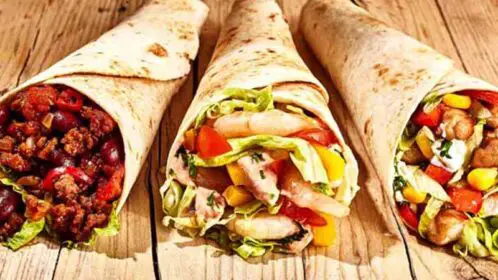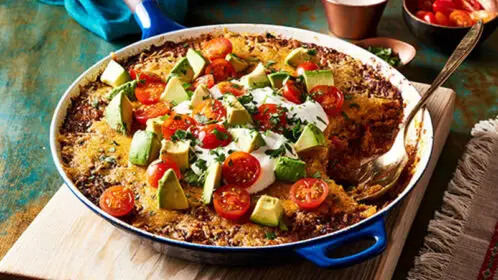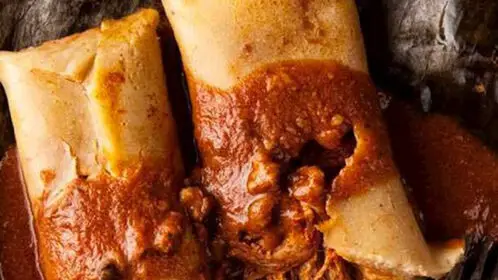Tamales in carbs are very beneficial for our body. Tamales are a fun treat that South American cultures and many other parts of the world have enjoyed for centuries.
Not only do these delicious morsels of food taste great, but they are suitable for you too. In this article, we’ll give you the scoop on how you can eat more carbs in your tamales than other types of food.
A Brief History of Tamales & Nutrition Facts
tamales have been around since the year 1530 and were created by Ignacio Zamora de Estrella. Tamales are said to have originated in the Philippines and were used by the Filipinos as an alternative to rice.
A significant influence of the tamale is its resemblance to the United States “jelly dough,” This was also used to explain why the tamale could only be eaten out of the hands. That is, the outside of the container.
The Mexican version called taco is cooked in an oven as this is how it is served.

Tamales are loved worldwide, although the Mexican tamale seems to be the more popular choice. A Mexican tamale can be prepared as thin as four ounces of rice flour or less and as thick as seven ounces.
The tamale filling can be made of corn, cheese, meat, vegetables, or fruits and served along with salsa and hot sauce.
Tamales can be found almost everywhere in Mexico, especially in the south-eastern part of the country.
The history of tamales is just a tiny glimpse into the history of food and how we have adapted it into our modern times. They are still being eaten by people worldwide and have not lost much of their popularity.
Tamales have always been known to have solid Mexican influences. And it is only natural that the tamale came to have such a close link with Mexico.
We should celebrate this link with Mexican tamales and learn a little more about this great Mexican dish.
Nutrition Facts About Tamales
Nutrition facts about tamales can help you make the best tamales for your family’s consumption.
These are healthy enough dishes that you and your loved ones will surely love. This Mexican delicacy is rich in taste and packed with nutrition, too.

A typical tamale or corn tamale is typically a dough-like dish, made from masa dough or maize bread. Steamed on a heated corn husk or banana leaf to form a deep, stuffing-rich dough.
Often served as a breakfast food, a tamale can also be done as a main dish. Tamales may be served plain or with added sauce or served with tortilla chips, shredded lettuce, chopped tomato, and salsa to make it more filling.
The wrappers may either be used as plates or discarded before serving.
In the North, Central, and South American countries, tamales are associated with a particular time of day: Friday Night Dinner.
The cornmeal or maize meal that forms the tamale filling is wrapped in banana leaves and steamed until dark.
The nutrition facts about tamales will show that a serving of these corn-based tamales has more than the body’s necessary vitamin and mineral contents.
Calories
How many calories are in totals? Tomales, the spicy, spiced food of the Mesoamerican culture, maybe as low in calories. As a hot dog on a hot summer day.
A typical tamale is a thin, usually crescent-shaped, breaded round snack with various fillings. Such as meats, vegetables, cheese, fruit, and more.
The filling varies but is almost always cheese, and the heart used is always beef. The wrapping is often used as a whole plate and discarded before eating.
The meal can be enjoyed and good for you; however, there are few good nutritional values to the average Mesoamerican diet.
Protein and Fiber
A question I get asked a lot from people is, what do you mean by protein and fiber? They see the term many times in magazines, and they want to know what it means.
I get asked this because most people don’t know what they are eating. How much of it they should be getting, and how it affects their bodies. You can find answers to your questions about what do you mean by protein and fiber in this article.
Let’s take a look at the two ingredients together and how you can benefit from them both!
Extra Vitamins & Minerals
When people start getting older, they usually slow down on certain things, affecting their health in the long run.
One of these is a lack of vitamins and minerals in their diet. This is a big problem for many people because not getting enough of these substances can make a person sick.
Fortunately, there are some things you can do to make sure you get what you need. Getting the proper amount of vitamins and minerals is essential for everyone, even those who aren’t as healthy as they used to be.
If you need to know how much extra you should be getting, here are a few tips for you:
LOW CARB KETO BEEF TAMALES
Low Carb Keto BEEF Tamales is very popular in South-East Asia, especially for their low carbohydrate and high protein levels. In Japan, they are called Tamago.
Many’s prefer Low Carb Keto BEEF to rice because of the high carbohydrate and lower rice index. Low Carb Keto BEEF is a type of meat or chicken baked in a deep pan, usually steamed and sprinkled with tropical seasonings like lime, garlic, fish sauce, etc. It can also be grilled, stewed, fried, or sauteed.

It’s healthy food. A lot of vegetarians and people are trying to lose weight and have managed to do so.
It is an excellent source of protein and carbohydrates. It contains vitamins A, B, C, D, E, K, and Omega-3 fatty acids, all of which are important to your health. So low carbohydrate keto vegetarian tamales taste good!
The preparation of these tamales is pretty simple, and cooking instructions are pretty obvious. A thick layer of work is spread over the bottom and sides, steamed and topped with vegetables, herbs, and spices.
All you need to do is place the main ingredient into the middle and cover it with seafood. Cover the lid of the pan tightly, after which it will steam up for about 20 minutes.
When done, you can slide off the pan easily, and that’s all there are too Low Carb Keto BEEF tamales.
You may like: Soybean Oil Fodmap
Information about carbs in Tamales
One of the more popular foods on the planet is tamales, so this is an excellent place to start looking for information about carbs in tamales.
Tamales are primarily corn-based, though they can use wheat flour, rice flour, and cornmeal. However, most Mexican restaurants, particularly those from the South, will serve their tamales with steamed white rice or some other flour type.
It is also important to note that corn is not one of the Mexican diet’s main staples, as it is not a staple of the Mexican diet, nor is it a staple of the South American diet.
Thus, while corn is used while there are some dishes, it is not the central part of the meal. This makes Tamales a great food to learn about the effects of carbs in tamales since almost anyone can enjoy them.
This also makes them an excellent meal to prepare for a group of friends, since everyone can enjoy them.
Finally, many people do not realize that it is possible to get more than one serving of carbs in a meal from these sweet treats. It is not uncommon to have tamales with ten different types of carbs, each having its unique flavor and purpose.
In some cases, one might even have tamales with altogether other purposes, such as being a high fiber food or having a high antioxidant content (such as in green salsa). This means that the information about carbs in tamales is endless since one can find a use for every part of the meal.
What is the carbon of tamal?
Tamal green tea or Tetsubin is a variety of green tea with a shallow level of caffeine. This tea’s caffeine content is less than one percent, making it one of the more popular tea types on account of its milder stimulant properties.
It also has less of the after-effects of caffeine that can cause you to feel jittery and anxious. This tea doesn’t seem to have as much after taste as other teas and is sometimes considered milder in flavor than other teas like oolong and jasmine.

Some studies have shown a different absorption rate of caffeine between caffeine-sensitive and those who aren’t. Still, these studies have been primarily conducted on postmenopausal women rather than those who are not pregnant.
Based on these results, we can conclude that there is no significant difference in the caffeine absorption levels of those who drink caffeinated and non-caffeinated versions of tall green tea.
One of the reason’s why this substance is effective at increasing serotonin absorption (one of the significant causes of mania and depression) is that it contains catechin polyphenols.
These compounds work to modify the rate at which fat is absorbed into the bloodstream after a meal and appear to speed up fat absorption. Other studies have shown that catechins are capable of reducing body weight in both overweight and obese people.
Tamales carbs are an example of how to keep our body fresh …
Tamales have been one of the most popular snacks in the Philippines and other parts of Asia. These tasty morsels can be found all over the island and are enjoyed by people from different walks of life.
They are a great source of protein and carbohydrates and a great source of minerals, fiber, and vitamins. There is no surprise why these little gems have become as popular as they have been in the past few decades.
This delicious snack has a high amount of protein, which helps the body to gain energy. They are also rich in carbohydrates, which are used to give the body energy and keeps it strong.
Tamales are also high in fiber, making sure that the body gets enough nutrients while consuming them. Lastly, Tamales have a small amount of sodium, making them an excellent choice for salt reduction.
If you do not like salty foods too much, you will find this filling enough and flavorful enough to satisfy your appetite.
Having enough sources of carbs and proteins keeps our body in good condition and ready for any health problems that may come our way.
Consuming foods like Tamales will ensure that we get the right amount of proteins and vitamins while ensuring that we are getting minerals and fiber.
Since these little gems are full of vitamins and minerals, we do not have to worry about any deficiency in any area.

Appreciating the dedication you put into your website and detailed information you present.
It’s awesome to come across a blog every once in a while that isn’t the same unwanted rehashed information. Great read!
I’ve saved your site and I’m including your RSS feeds
to my Google account.
I do not even know how I ended up here, but I thought this post was great.
I don’t know who you are but certainly you’re going to a famous blogger if you aren’t already 😉 Cheers!
Hi to all, the contents existing at this site are
actually remarkable for people experience, well, keep up
the nice work fellows.
Thanks for the good writeup. It in reality was once a enjoyment account
it. Look complicated to more added agreeable from you!
However, how can we keep in touch?
It’s awesome to pay a visit this web site and reading the views of all colleagues about
this piece of writing, while I am also keen of getting know-how.